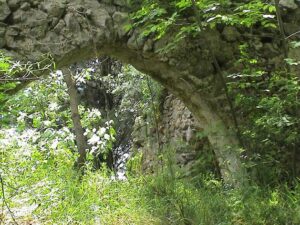MUNICIPALITY: Tramonti
NAME: Villa rustica (Roman era)
LOCATION: Polvica
DESCRIPTION: The most important and still visible evidence is a part of the Roman villa in the locality of Polvica in Tramonti. During excavation for the construction of a road, in the area between the headquarters of the local “Comunità Montana” and the municipal house, in the 1980s of the last century, important archaeological evidence came to light ranging from the Hellenistic to the medieval period (for convenience of synthesis, they will be described according to the era to which they date).
Hellenistic era
In the area where the parking lot was built, post holes were discovered with remains of black-painted pottery that dated to the Hellenistic Age and not the Bronze Age, as was first assumed.
Roman era
Cultivation furrows were found in the area immediately south of the villa’s planting (in the area of the present parking lot) that dated to the Roman era, at a time before the eruption of A.D. 79, and appeared to be sealed by lapilli transported here by the wind at high altitude.
In the area closest to the slopes of the hill, the remains of the Roman villa were discovered; they consists of two overlapping structures, the older one (1st century B.C.), served as the foundation of the new facility, of which survive the remains of four rooms, oriented north-south, and a cocciopesto floor.
The masonry technique is the opus listatum (a construction technique made by parallel horizontal courses of tuff blocks alternated with bricks) with remnants of plaster covering.
To the west, about 10.00 meters from the villa, a cistern was excavated.
Some tombs (tombe a cappuccina*) discovered 3.50 meters south of the facility, and some amphorae discovered 200 meters southeast, date to this same period.
Of the material collected immediately after the discovery, some fragments date from before A.D. 79, and others from after this date.
Among the oldest pottery are fragments of aretina pottery: two belong to a plate and are internally decorated with wheel motifs (a rotellatura*); one has remnants of pictorial decoration of which only the leg of an individual is visible; then there are fragments of rims belonging to commonly used pottery, one of which can be associated to an open shape.
Fragments after A.D. 79 can be traced to a rim and handle of an amphora of African provenance with a double-stepped lip (labbro a doppio gradino*) (3rd century A.D.), an earthen jar (2nd century A.D.), a tapered patera rim in African sealed pottery, and a wall with painted interior (4th-7th century A.D.).
Medieval era
The implantation of a place of worship to the west of the villa dates to the medieval period, of which the apse and the walls of the north side survived at the time of discovery, while now only a few remnants of a north wall can be seen.
The area covered by the discoveries must have benefited from an excellent road system still visible today in numerous paths that easily connect it to the Valico di Chiunzi to the north, and to the coast to the south.
SEE, VISIT, FIND: All the structures were affected in the 1990s by an excavation, of which no documentation could be consulted because it has yet to be printed. In addition, parts of these structures are currently voluntarily buried, while others are covered by spontaneous vegetation and garbage.
Access is granted only for study purposes with a request to the Salerno Archaeological Superintendency.
FRUITION DATA: None
OPPORTUNITIES: The site should be illustrated at least from the outside, through information material and panels on site (most people are unaware of the presence of ancient structures situated there). It could also be integrated into an organic presentation of the evidence of classical archaeology in the Amalfi Coast, and usefully compared with the different settlement patterns of the coastal strip (as is already done in the Antiquarium of the Maritime Villa in Minori).
BIBLIOGRAPHY: ROTA L. – IANNELLI M. A., Antiquarium di Minori, La Villa Marittima romana, Minori 1998 (also in english). ROMITO M., Una villa rustica romana a Polvica di Tramonti, in RCCSA 1986.
ROMITO M., Una villa rustica romana a Polvica di Tramonti, in RCCSA 1986.



